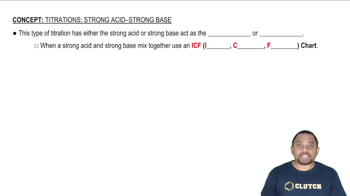Here are the essential concepts you must grasp in order to answer the question correctly.
pH Scale
The pH scale measures the acidity or basicity of a solution, ranging from 0 to 14. A pH of 7 is neutral, values below 7 indicate acidity, and values above 7 indicate basicity. The pH is calculated as the negative logarithm of the hydrogen ion concentration in the solution, with lower pH values corresponding to higher concentrations of hydrogen ions.
Recommended video:
Concentration and Molarity
Concentration refers to the amount of solute present in a given volume of solution. Molarity, a common unit of concentration, is defined as moles of solute per liter of solution. To determine the pH of a NaOH solution, one must first convert the mass percentage to molarity, which involves calculating the number of moles of NaOH in a specific volume of the solution.
Recommended video:
Dissociation of Strong Bases
Strong bases, like sodium hydroxide (NaOH), completely dissociate in water to produce hydroxide ions (OH⁻). This complete dissociation means that the concentration of hydroxide ions in the solution is equal to the molarity of the NaOH. The pOH can be calculated from the hydroxide ion concentration, and the pH can then be derived using the relationship pH + pOH = 14.
Recommended video:
Strong Acid-Strong Base Titration
 Verified step by step guidance
Verified step by step guidance

